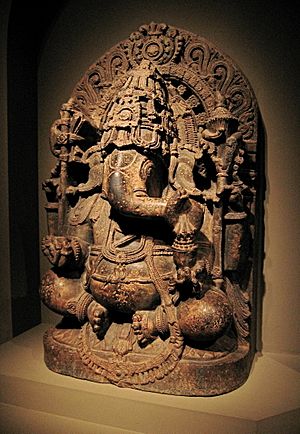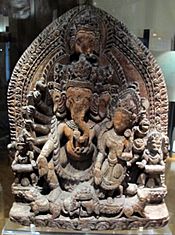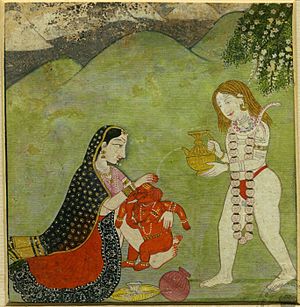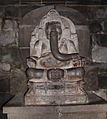Ganesha facts for kids
Quick facts for kids Ganesha |
|
|---|---|
| God of Luck and New Beginnings Remover of Obstacles Supreme God (Ganapatya) |
|
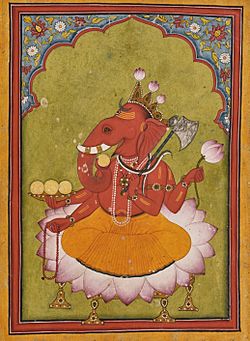
Basohli miniature, c. 1730. National Museum, New Delhi.
|
|
| Affiliation | Deva, Brahman (Ganapatya), Saguna Brahman (Panchayatana puja) |
| Abode | • Mount Kailash (with parents) • Swanandhlok |
| Mantra | Oṃ Ekadantaya Vidmahe,Vakrathundaya Dhimahi,Thanno Danthi Prachodhayat Oṃ Shri Gaṇeśāya Namaḥ Oṃ Gaṃ Gaṇapataye Namaḥ |
| Weapon | Paraśu (axe), pāśa (noose), aṅkuśa (elephant goad) |
| Symbols | Swastika, Om, Modak |
| Mount | Mouse |
| Texts | Ganesha Purana, Mudgala Purana, Ganapati Atharvashirsa |
| Gender | Male |
| Festivals | Ganesh Chaturthi, Diwali |
| Personal information | |
| Consort | Riddhi and Siddhi or celibate |
| Parents | |
| Siblings | Kartikeya (brother) |
| Equivalents | |
| Buddhists equivalent | Kangiten |
Ganesha (Sanskrit: गणेश, IAST: Gaṇeśa), also known as Ganapati, Vinayaka, and Pillaiyar, is one of the best-known and most worshipped gods in the Hindu pantheon and is the Supreme God in Ganapatya sect. His image is found throughout India. Devotion to Ganesha includes Nepal, Sri Lanka, Thailand, Indonesia (Java and Bali), Singapore, Malaysia, Philippines, and Bangladesh and in countries with large ethnic Indian populations including Fiji, Guyana, Mauritius, and Trinidad and Tobago.
Although Ganesha has many attributes, he is readily identified by his elephant head. He is widely revered, more specifically, as the remover of obstacles and thought to bring good luck; the patron of arts and sciences; and the deva of intellect and wisdom. As the god of beginnings, he is honoured at the start of rites and ceremonies. Ganesha is also invoked as a patron of letters and learning during writing sessions.
Scholars differ about his origins dating him between 1st century BCE and 2nd century CE. Hindu mythology identifies Ganesha as the son of Parvati and Shiva of the Shaivism tradition, but he is a pan-Hindu god found in its various traditions. In the Ganapatya tradition of Hinduism, Ganesha is the Supreme Being. The principal texts on Ganesha include the Ganesha Purana, the Mudgala Purana and the Ganapati Atharvasirsha.
Contents
Etymology and other names
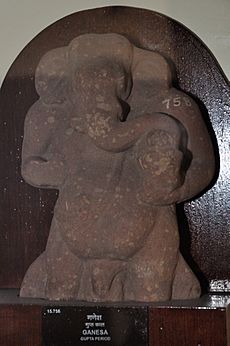
The name Ganesha is a Sanskrit compound, joining the words gana (gaṇa), meaning a 'group, multitude, or categorical system' and isha (īśa), meaning 'lord or master'. The word gaṇa when associated with Ganesha is often taken to refer to the gaṇas, a troop of semi-divine beings that form part of the retinue of Shiva, Ganesha's father. The term more generally means a category, class, community, association, or corporation.
Some commentators interpret the name "Lord of the Gaṇas" to mean "Lord of Hosts" or "Lord of created categories", such as the elements.
Iconography
Ganesha is a popular figure in Indian art. He may be portrayed standing, dancing, heroically taking action against demons, playing with his family as a boy, sitting down on an elevated seat, or engaging in a range of contemporary situations.
In rare instances, he may be depicted with a human head.
Common attributes
Ganesha has been represented with the head of an elephant since the early stages of his appearance in Indian art. Puranic myths provide many explanations for how he got his elephant head. While some texts say that Ganesha was born with an elephant head, he acquires the head later in most stories. The most recurrent motif in these stories is that Ganesha was created by Parvati using clay to protect her and Shiva beheaded him when Ganesha came between Shiva and Parvati. Shiva then replaced Ganesha's original head with that of an elephant. Details of the battle and where the replacement head came from vary from source to source. Another story says that Ganesha was created directly by Shiva's laughter. Shiva gave him the head of an elephant and a protruding belly.
Ganesha's earliest name was Ekadanta (One Tusked), referring to his single whole tusk, the other being broken. Some of the earliest images of Ganesha show him holding his broken tusk.
The number of Ganesha's arms varies; his best-known forms have between two and sixteen arms. Many depictions of Ganesha feature four arms. Some people view Ganesha's trunk as an arm and for that reason say Ganesha has five arms.
Forms with 14 and 20 arms appeared in Central India during the 9th and the 10th centuries.
The serpent is a common feature in Ganesha iconography and appears in many forms. According to the Ganesha Purana, Ganesha wrapped the serpent Vasuki around his neck. Other depictions of snakes include use as a sacred thread (IAST: yajñyopavīta) wrapped around the stomach as a belt, held in a hand, coiled at the ankles, or as a throne. Upon Ganesha's forehead may be a third eye or the sectarian mark (IAST: tilaka), which consists of three horizontal lines.
Ganesha is often described as red in colour.
Features
Removal of obstacles
Ganesha is Vighneshvara (Vighnaraja, Marathi – Vighnaharta), the Lord of Obstacles, both of a material and spiritual order. He is popularly worshipped as a remover of obstacles, though traditionally he also places obstacles in the path of those who need to be checked. He is often worshipped by the people before they begin anything new.
Buddhi (Intelligence)
Ganesha is considered to be the Lord of letters and learning. In Sanskrit, the word buddhi is an active noun that is variously translated as intelligence, wisdom, or intellect. The concept of buddhi is closely associated with the personality of Ganesha, especially in the Puranic period, when many stories stress his cleverness and love of intelligence.
Family and consorts
Though Ganesha is popularly held to be the son of Shiva and Parvati, the Puranic texts give different versions about his birth. In some he was created by Parvati, or by Shiva or created by Shiva and Parvati, in another he appeared mysteriously and was discovered by Shiva and Parvati or he was born from the elephant headed goddess Malini after she drank Parvati's bath water that had been thrown in the river.
The family includes his brother, the god of war, Kartikeya, who is also called Skanda and Murugan. Regional differences dictate the order of their births. In northern India, Skanda is generally said to be the elder, while in the south, Ganesha is considered the firstborn. In northern India, Skanda was an important martial deity from about 500 BCE to about 600 CE, after which worship of him declined significantly. As Skanda fell, Ganesha rose. Several stories tell of sibling rivalry between the brothers and may reflect sectarian tensions.
Ganesha's marital status varies widely in mythological stories. One pattern of myths identifies Ganesha as an unmarried brahmachari. This view is common in southern India and parts of northern India. Another popularly-accepted mainstream pattern associates him with the concepts of Buddhi (intellect), Siddhi (spiritual power), and Riddhi (prosperity); these qualities are personified as goddesses, said to be Ganesha's wives. He also may be shown with a single consort or a nameless servant (Sanskrit: daşi). Another pattern connects Ganesha with the goddess of culture and the arts, Sarasvati or Śarda (particularly in Maharashtra). He is also associated with the goddess of luck and prosperity, Lakshmi. Another pattern, mainly prevalent in the Bengal region, links Ganesha with the banana tree, Kala Bo.
The Shiva Purana says that Ganesha had begotten two sons: Kşema (safety) and Lābha (profit). In northern Indian variants of this story, the sons are often said to be Śubha (auspiciousness) and Lābha. The 1975 Hindi film Jai Santoshi Maa shows Ganesha married to Riddhi and Siddhi and having a daughter named Santoshi Ma, the goddess of satisfaction. This story has no Puranic basis, but Anita Raina Thapan and Lawrence Cohen cite Santoshi Ma's cult as evidence of Ganesha's continuing evolution as a popular deity.
Worship and festivals
Ganesha is worshipped on many religious and secular occasions, especially at the beginning of ventures such as buying a vehicle or starting a business. Devotees believe that if Ganesha is happy, he grants success, prosperity and protection against adversity.
Devotees offer Ganesha sweets such as modaka and small sweet balls called laddus. He is often shown carrying a bowl of sweets, called a modakapātra. Because of his identification with the color red, he is often worshipped with red sandalwood paste (raktachandana) or red flowers. Dūrvā grass (Cynodon dactylon) and other materials are also used in his worship.
Festivals associated with Ganesh are Ganesha Chaturthi or Vināyaka chaturthī in the śuklapakṣa (the fourth day of the waxing moon) in the month of Bhadrapada (August/September) and the Ganesh Jayanti (Ganesha's birthday) celebrated on the cathurthī of the śuklapakṣa (fourth day of the waxing moon) in the month of magha (January/February)."
Ganesha Chaturthi
An annual festival honours Ganesha for ten days, starting on Ganesha Chaturthi, which typically falls in late August or early September. The festival begins with people bringing in clay idols of Ganesha, symbolising the god's visit. The festival culminates on the day of Ananta Chaturdashi, when the idols (murtis) are immersed in the most convenient body of water. Some families have a tradition of immersion on the 2nd, 3rd, 5th, or 7th day. In 1893, Lokmanya Tilak transformed this annual Ganesha festival from private family celebrations into a grand public event. Tilak was the first to install large public images of Ganesha in pavilions, and he established the practice of submerging all the public images on the tenth day.
Today, Hindus across India celebrate the Ganapati festival, though it is most popular in the state of Maharashtra. The festival also assumes huge proportions in Mumbai, Pune, and in the surrounding belt of Ashtavinayaka temples.
Temples
There are many other important Ganesha temples at the following locations: Siddhivinayak temple in Mumbai, Ganpatipule temple at Ganpatipule, Binkhambi Ganesh mandir in Kolhapur, Jai Vinayak temple in Jaigad, Ratnagiri, Wai in Maharashtra; Ujjain in Madhya Pradesh; Jodhpur, Nagaur and Raipur (Pali) in Rajasthan; Baidyanath in Bihar; Baroda, Dholaka, and Valsad in Gujarat and Dhundiraj Temple in Varanasi, Uttar Pradesh. Prominent Ganesha temples in southern India include the following: Kanipakam in Andhra Pradesh; the Rockfort Ucchi Pillayar Temple at Tiruchirapalli and Puliakulam Munthi Vinayagar Temple at Coimbatore in Tamil Nadu; Kottarakkara, Pazhavangadi, Kasargod in Kerala; Hampi, and Idagunji in Karnataka; and Bhadrachalam in Telangana.
Images for kids
-
Street festivities in Hyderabad, India during the festival of Ganesha Chaturthi
-
Ganesha statue in 9th-century Prambanan temple, Java, Indonesia
See also
 In Spanish: Ganesha para niños
In Spanish: Ganesha para niños


